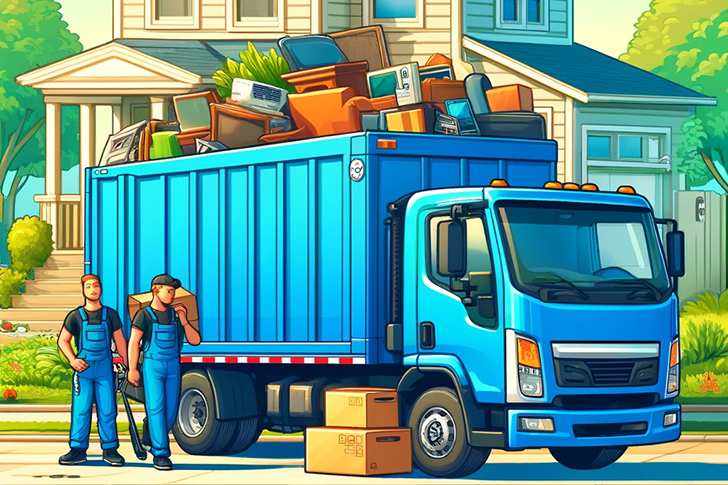American: How to Reduce Costs on Junk Hauling Services
In the bustling day-to-day of American life, accumulating unwanted items is almost inevitable. Whether it’s old furniture, electronic waste, or general clutter, disposing of junk can be a daunting task. However, finding affordable junk removal services doesn’t have to break the bank. This guide delves into strategies for securing cost-effective junk disposal options, alongside insights into the industry that might help you make informed decisions.

Understanding the Junk Removal Industry
The junk removal industry in the U.S. has seen steady growth, driven by increasing consumer consumption and the subsequent need for waste management solutions. The industry generates over $10 billion annually and is expected to grow as environmental concerns and recycling initiatives become more prevalent. Typically, the cost of junk removal services can vary widely based on factors like location, type of material, volume, and accessibility.
Tips for Securing Affordable Junk Removal Services
- Assess and Separate Your Junk: Start by evaluating what you have. Some items might be recyclable, which can sometimes be picked up for free by local services. Metals, electronics, and certain types of plastics fall into this category. By separating recyclables from the trash, you reduce the volume of junk, potentially lowering the cost of removal services.
- Compare Local Services: Prices and services vary by company. Use websites like Angie’s List, Yelp, or local Facebook groups to compare rates and read reviews. Don’t hesitate to call and ask for a quote; some companies might offer a discount if you can describe the job accurately over the phone.
- Bulk Together with Neighbors: If several houses in the neighborhood need junk removal, consider pooling the jobs. Many companies offer discounts for larger volumes, so coordinating with others can lead to lower costs for everyone involved.
- Look for Special Promotions: Companies often run special promotions during off-peak times of the year. Following local junk removal services on social media or signing up for their newsletters can keep you informed about discount offers.
- Donate What You Can: Donating items that are still in good condition can reduce the volume of what needs to be removed and potentially qualify you for a tax deduction. Organizations like Goodwill, The Salvation Army, or local thrift stores often accept donations of usable goods.
- Choose the Right Time: The demand for junk removal typically spikes during weekends and summer months. Scheduling a pickup during a weekday or off-peak season can often result in lower costs.
- Negotiate: Don’t be afraid to negotiate the price. If you get a lower quote from one company, see if others can match or beat it.
- Self-Service Dumpster Rental: For large projects, renting a dumpster might be a cost-effective option. This choice is particularly sensible if you’re willing to do the hauling and loading yourself.
- Municipal Pickup Services: Many cities offer bulk trash pickup for free or at a reduced cost. Check your city’s official website for details on services and scheduling.
- Go Green: Companies specializing in eco-friendly junk removal often offer competitive pricing, as they can offset costs through recycling and re-selling salvageable items.
Facts and Figures
- The average cost for basic junk removal in the U.S. ranges from $150 to $350.
- Nearly 75% of all junk removed from residential properties is recyclable.
- Local promotions can save up to 20% off standard junk removal rates.
The practicality of affordable junk removal extends beyond just cost savings. It also plays a crucial role in environmental conservation. By opting for services that prioritize recycling and the responsible disposal of junk, you contribute to less landfill waste and lower the environmental impact of your clean-up activities.
Leveraging Technology for Better Deals
Technology can also play a pivotal role in reducing the cost of junk removal services. Many companies now offer apps or websites where you can easily book services, schedule pickups, and even receive instant quotes based on photos of the junk you want removed. This not only makes the process more efficient but also helps in getting more accurate estimates, potentially reducing the cost by avoiding overestimations.
- Use Apps for Instant Quotes: Apps like ‘Gone for Good’ or ‘Junk King’ allow you to upload pictures of your junk and receive an immediate quote. This can be particularly useful for ensuring you only pay for the space your junk occupies in their truck.
- Virtual Consultations: Some companies offer virtual consultations where you can walk an agent through your home via a video call to assess the junk. This saves on the cost and time for both parties and can lead to more competitive pricing.
- Online Booking Discounts: Look for companies that offer discounts for online bookings. Since online bookings save the company time and administrative costs, they often pass these savings onto customers.
Participating in Community Environmental Programs
Another way to manage junk removal costs is by participating in community environmental programs. Many communities organize days where residents can dispose of large items and hazardous materials for free, which are sponsored by local governments or environmental agencies. These events not only help in disposing of junk responsibly but also promote community involvement and environmental awareness.
- Community Clean-Up Days: Participate in or organize community clean-up days, which are often supported by local businesses or municipal resources.
- Hazardous Waste Collection: Take advantage of free hazardous waste collection days to dispose of items like paints, batteries, and electronic waste without any cost.
- Educational Workshops: Join workshops that teach how to minimize waste or repurpose items, which can reduce the amount of junk generated over time.
By employing these strategies, you can effectively manage the costs associated with junk removal while also contributing positively to your community and environment. The key is to stay informed, compare options, and make choices that align with both your budget and environmental values.







Recent Comments